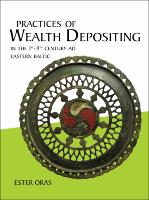Practices of Wealth Depositing in the 1st–9th Century AD Eastern Baltic
| dc.contributor.author | Oras, Ester | |
| dc.date.accessioned | 2021-03-10T16:30:27Z | |
| dc.date.available | 2021-03-10T16:30:27Z | |
| dc.date.issued | 2015 | |
| dc.identifier | ONIX_20210310_9789088903076_35 | |
| dc.identifier | OCN: 959278432 | |
| dc.identifier.uri | https://library.oapen.org/handle/20.500.12657/47194 | |
| dc.description.abstract | This PhD thesis discusses the practices of wealth depositing in the 1st–9th century AD eastern Baltic (Estonia, Latvia, Lithuania). Wealth deposits are one or more valued object/s that is/are hidden deliberately as an intended separate deposition in a selected place in a specific, distinguishable manner. Wealth depositing is regarded as an important cultural practice which relates to and derives from various past social phenomena and changes respectively in spatial and temporal terms. It is emphasised that wealth deposits should be analysed as a cohesive corpus of material, regardless of specific artefact types, functional groups, production material, environment of concealment, and most importantly without any predetermined interpretation categorisations. The dissertation presents different patterned practices of concealing valuables in the 1st–9th century AD eastern Baltic through a detailed contextual analysis of their main material characteristics: artefacts, their assemblages and appearance, environment of concealment, chronology and location in the cultural landscape. The study demonstrates how depositional practices change in time and space, and analyses relations between specific depositional practices and developments on a wider social scale. A comparative analysis of wealth deposits and important social changes in contemporary society based on overall archaeological material is presented. The key regional and cross-regional practices of wealth depositing in the 1st–9th century AD eastern Baltic are identified. Additionally, further comparisons are drawn between depositional practices in the eastern Baltic and other parts of the Baltic Sea region, especially Scandinavia. This thesis contributes to the discussions of concepts of value and depositional practices in a long-term and cross-regional perspective. A further aim is to look beyond the problematic ‘why?’-questions posed in the studies of wealth deposits, and move instead to more comprehensible questions of ‘how?’: how do depositional practices change in time and space, and how are these processes related to developments in a broader social context? The book contains a catalogue of all the 1st-9th century AD Eastern Baltic deposits analysed in the dissertation with descriptions of objects, environments of concealment, find circumstances, illustrations/photos and further references. | |
| dc.language | English | |
| dc.subject.classification | thema EDItEUR::N History and Archaeology::NK Archaeology::NKD Archaeology by period / region | en_US |
| dc.subject.classification | thema EDItEUR::1 Place qualifiers::1D Europe | en_US |
| dc.subject.classification | thema EDItEUR::3 Time period qualifiers::3K CE period up to c 1500::3KL c 1000 CE to c 1500 | en_US |
| dc.subject.other | archaeology | |
| dc.subject.other | early middle ages | |
| dc.subject.other | iron age | |
| dc.subject.other | votive deposition | |
| dc.subject.other | ritual practices | |
| dc.title | Practices of Wealth Depositing in the 1st–9th Century AD Eastern Baltic | |
| dc.type | book | |
| oapen.relation.isPublishedBy | 471fd6d5-f295-4fd0-a13a-e60a6420f603 | |
| oapen.imprint | Sidestone Press Dissertations | |
| oapen.pages | 354 | |
| oapen.place.publication | Leiden |

